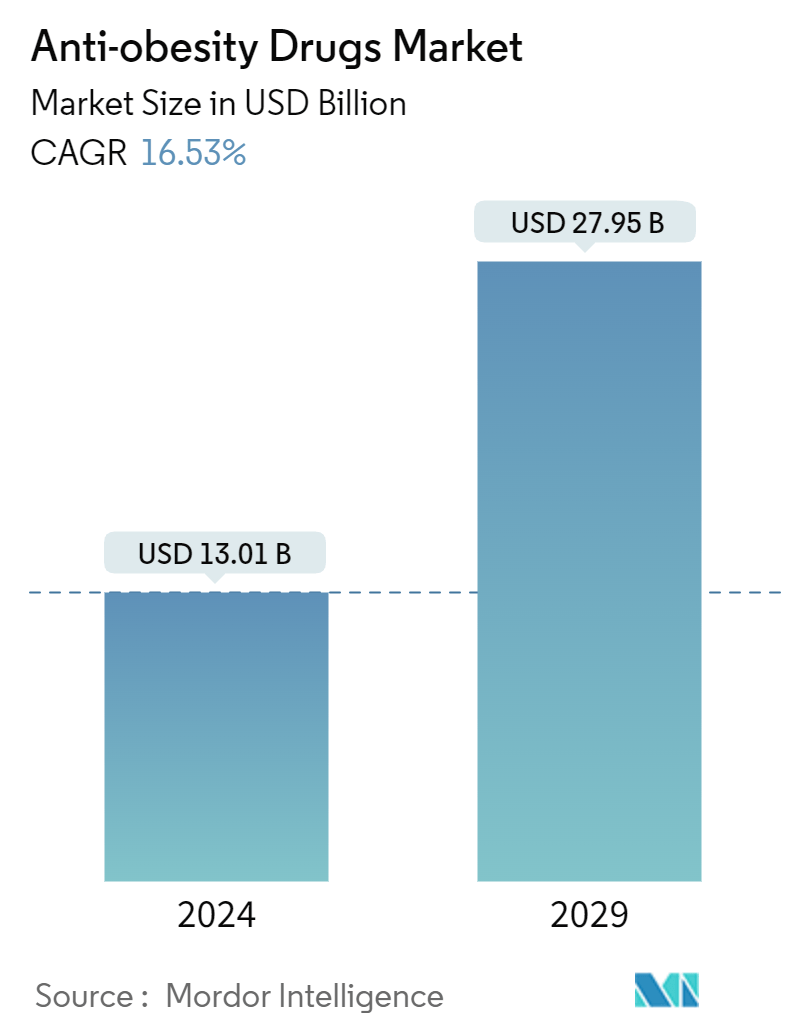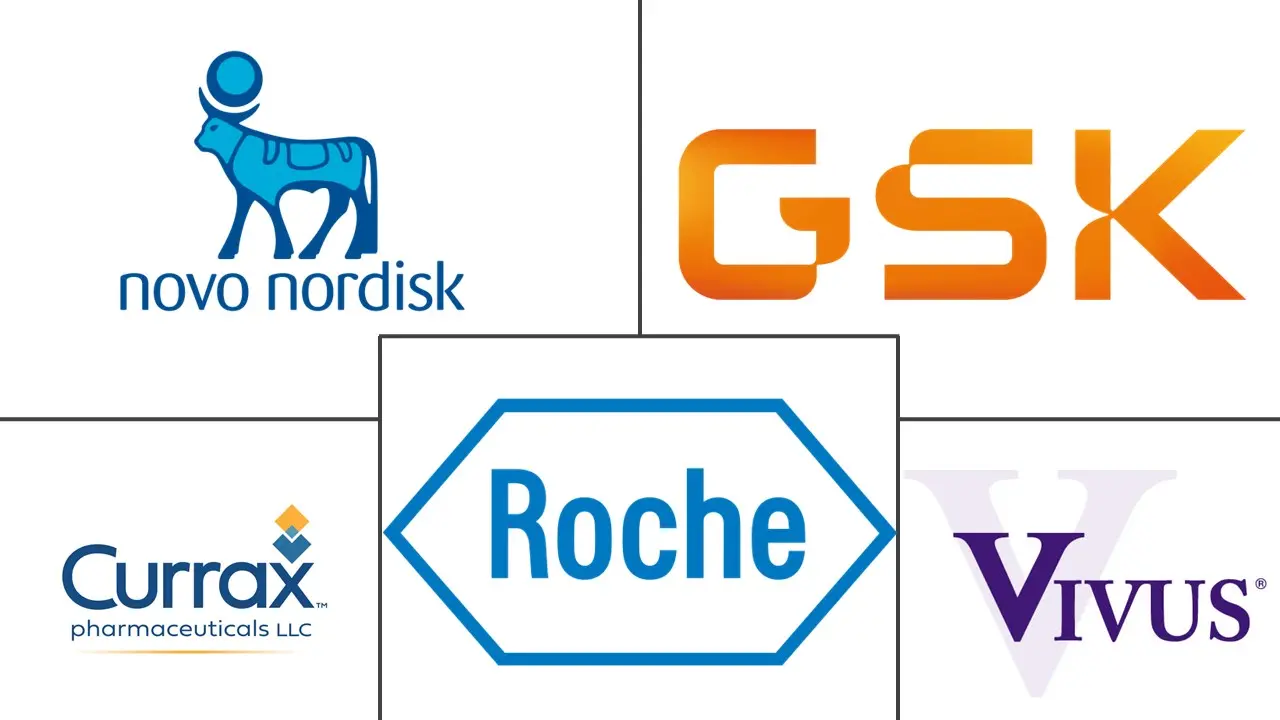Market Size of Anti-obesity Drugs Industry

| Study Period | 2019 - 2029 |
| Market Size (2024) | USD 13.01 Billion |
| Market Size (2029) | USD 27.95 Billion |
| CAGR (2024 - 2029) | 16.53 % |
| Fastest Growing Market | Asia Pacific |
| Largest Market | North America |
Major Players
*Disclaimer: Major Players sorted in no particular order |
Anti-Obesity Drugs Market Analysis
The Anti-obesity Drugs Market size is estimated at USD 13.01 billion in 2024, and is expected to reach USD 27.95 billion by 2029, growing at a CAGR of 16.53% during the forecast period (2024-2029).
During the COVID-19 situation, it was observed that obesity had increased exponentially. As per an article published by the European Journal of Nutrition in December 2020, the rate of obesity has increased in the world. The primary reason is a change in lifestyle and a decrease in exercise practice among people as they avoided gym and yoga classes due to the social distancing protocols. Similarly, according to the article published in Diabetes Obesity and Metabolism in August 2021, obesity prevalence is a significant and potentially modifiable risk factor for increased COVID-19 national caseload and mortality. This increased risk of the obese population leading to COVID-19 mortality which increased the demand for anti-obesity drugs during covid. However, increased awareness about healthy lifestyle and weight concerns during the pandemic are expected to maintain the demand of anti-obesity drugs even post-pandemic period.
According to the World Health Organization's report published in June 2021, 39 million children under the age of 5 years were overweight or obese in 2020. One in five children and adolescents globally is overweight. Incidences of obesity have been increasing fiercely over the past decades, and it is often described as a global endemic, especially in developed countries where lifestyle-related disorders, such as anxiety, stress, smoking, and drinking, are more prevalent. Owing to the increase in the obesity population worldwide, the key players in the market are initiating product developments and seeking market approvals. For instance, in January 2021, Novartis AG announced the results of its Phase II trial of the investigational product drug called Bimagrumab. The drug has shown potential for the indication of obesity. The drug is currently being studied in the Novartis pipeline. This may result in new treatment options, boosting market growth over the forecast period.
In addition, research on several potential drug molecules that target both obesity and Type 2 diabetes mellitus has become a key trend among the anti-obesity market players. The increasing epidemic of obesity and Type 2 diabetes is encouraging researchers and vendors in the market to research drugs that can counter both obesity and Type 2 diabetes. Hence, the increasing obese population, rise in unhealthy eating habits, and sedentary lifestyles are expected to drive the market growth over the forecast period.
However, the availability of alternative therapies and the potential side effects of anti-obesity drugs are expected to restrain the market growth.
Anti-Obesity Drugs Industry Segmentation
As per the scope of the report, anti-obesity drugs or weight loss medications are pharmacological agents that reduce or control weight. These medications alter one of the fundamental processes of the human body, weight regulation, by altering either appetite or absorption of calories. The anti-obesity drugs market is segmented by mechanism of action (peripherally acting drugs and centrally acting drugs), drug type (prescription drugs and OTC drugs), and geography (North America, Europe, Asia-Pacific, Middle-East and Africa, and South America). The market report also covers the estimated market sizes and trends for 17 different countries across major regions globally. The report offers the market size and forecasts in value (USD million) for the above segments.
| By Mechanism of Action | |
| Peripherally Acting Drugs | |
| Centrally Acting Drugs |
| By Drug Type | |
| Prescription Drugs | |
| OTC Drugs |
| Geography | ||||||||
| ||||||||
| ||||||||
| ||||||||
| ||||||||
|
Anti-obesity Drugs Market Size Summary
The anti-obesity drugs market is poised for significant growth, driven by the increasing prevalence of obesity globally, which has been exacerbated by lifestyle changes and the COVID-19 pandemic. The demand for these drugs surged during the pandemic due to the heightened risk of severe COVID-19 outcomes in obese individuals, leading to a sustained interest in anti-obesity treatments even as the pandemic recedes. The market is characterized by a focus on developing new drug therapies, with key players like Novartis AG and Novo Nordisk AS actively pursuing innovative solutions to address obesity and related conditions such as Type 2 diabetes. The rising awareness of health and wellness, coupled with the growing incidence of obesity, is expected to propel the market forward, despite challenges such as the availability of alternative therapies and potential side effects of existing drugs.
North America is anticipated to lead the global anti-obesity drugs market, supported by high healthcare expenditure and a significant obese population. The region's market growth is further bolstered by the presence of major pharmaceutical companies and ongoing research and development activities aimed at creating effective weight management solutions. The competitive landscape is marked by the involvement of both international and regional players, with companies like GlaxoSmithKline PLC, Pfizer Inc., and Bayer AG holding substantial market shares. The approval of new drugs and strategic partnerships, such as those by Novo Nordisk AS, are expected to enhance the market's growth trajectory. As the prevalence of obesity continues to rise, particularly in developed regions, the demand for anti-obesity drugs is likely to increase, driving market expansion over the forecast period.
Anti-obesity Drugs Market Size - Table of Contents
-
1. MARKET DYNAMICS
-
1.1 Market Overview
-
1.2 Market Drivers
-
1.2.1 Increasing Burden of Obesity and Related Chronic Diseases
-
1.2.2 Growing Unhealthy and Sedentary Lifestyles
-
-
1.3 Market Restraints
-
1.3.1 Availability of Alternative Treatment Options
-
1.3.2 Side Effects of Drugs
-
-
1.4 Industry Attractiveness - Porter's Five Forces Analysis
-
1.4.1 Threat of New Entrants
-
1.4.2 Bargaining Power of Buyers/Consumers
-
1.4.3 Bargaining Power of Suppliers
-
1.4.4 Threat of Substitute Products
-
1.4.5 Intensity of Competitive Rivalry
-
-
-
2. MARKET SEGMENTATION
-
2.1 By Mechanism of Action
-
2.1.1 Peripherally Acting Drugs
-
2.1.2 Centrally Acting Drugs
-
-
2.2 By Drug Type
-
2.2.1 Prescription Drugs
-
2.2.2 OTC Drugs
-
-
2.3 Geography
-
2.3.1 North America
-
2.3.1.1 United States
-
2.3.1.2 Canada
-
2.3.1.3 Mexico
-
-
2.3.2 Europe
-
2.3.2.1 United Kingdom
-
2.3.2.2 Germany
-
2.3.2.3 France
-
2.3.2.4 Italy
-
2.3.2.5 Spain
-
2.3.2.6 Rest of Europe
-
-
2.3.3 Asia-Pacific
-
2.3.3.1 China
-
2.3.3.2 Japan
-
2.3.3.3 India
-
2.3.3.4 Australia
-
2.3.3.5 South Korea
-
2.3.3.6 Rest of Asia-Pacific
-
-
2.3.4 Middle-East and Africa
-
2.3.4.1 GCC
-
2.3.4.2 South Africa
-
2.3.4.3 Rest of Middle-East and Africa
-
-
2.3.5 South America
-
2.3.5.1 Brazil
-
2.3.5.2 Argentina
-
2.3.5.3 Rest of South America
-
-
-
Anti-obesity Drugs Market Size FAQs
How big is the Anti-obesity Drugs Market?
The Anti-obesity Drugs Market size is expected to reach USD 13.01 billion in 2024 and grow at a CAGR of 16.53% to reach USD 27.95 billion by 2029.
What is the current Anti-obesity Drugs Market size?
In 2024, the Anti-obesity Drugs Market size is expected to reach USD 13.01 billion.

